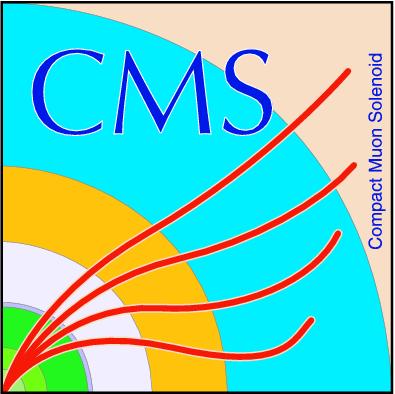

Compact Muon Solenoid
LHC, CERN
| CMS-PAS-HIN-21-013 | ||
| Observation of enhanced long-range elliptic anisotropies inside high-multiplicity jets in pp collisions at the LHC | ||
| CMS Collaboration | ||
| 21 June 2023 | ||
| Abstract: A search for QCD collective effects is performed with the CMS experiment via correlation measurements of charged constituents inside jets produced in proton-proton collisions at the LHC. The analysis uses data collected at a center-of-mass energy of √s = 13 TeV, corresponding to an integrated luminosity of 138 fb−1. For charged constituents within a reconstructed jet of cone radius 0.8, two-particle correlations as functions of relative azimuthal angle (Δϕ∗) and pseudorapidity (Δη∗) are performed in a novel ``jet frame,'' where constituent η, ϕ variables are redefined relative to the direction of the jet. The correlation functions are studied in classes of in-jet charged-particle multiplicity up to nearly 100. Anisotropy Fourier harmonics are extracted from long-range azimuthal correlation functions for |Δη∗|> 2. For low-multiplicity jets, the long-range elliptic anisotropy harmonic, vj2, is observed to decrease with multiplicity. This trend is well described by Monte Carlo (MC) event generators. However, a rising trend of vj2 emerges at an in-jet charged-particle multiplicity above ≈ 80. This trend is not reproduced by MC models. This observation yields new insights into the dynamics of parton fragmentation processes in the vacuum. This document has been revised with respect to the version dated June 21, 2023. | ||
|
Links:
CDS record (PDF) ;
CADI line (restricted) ;
These preliminary results are superseded in this paper, Submitted to PRL. The superseded preliminary plots can be found here. |
||
| Figures | Summary | Additional Figures | References | CMS Publications |
|---|
| Figures | |
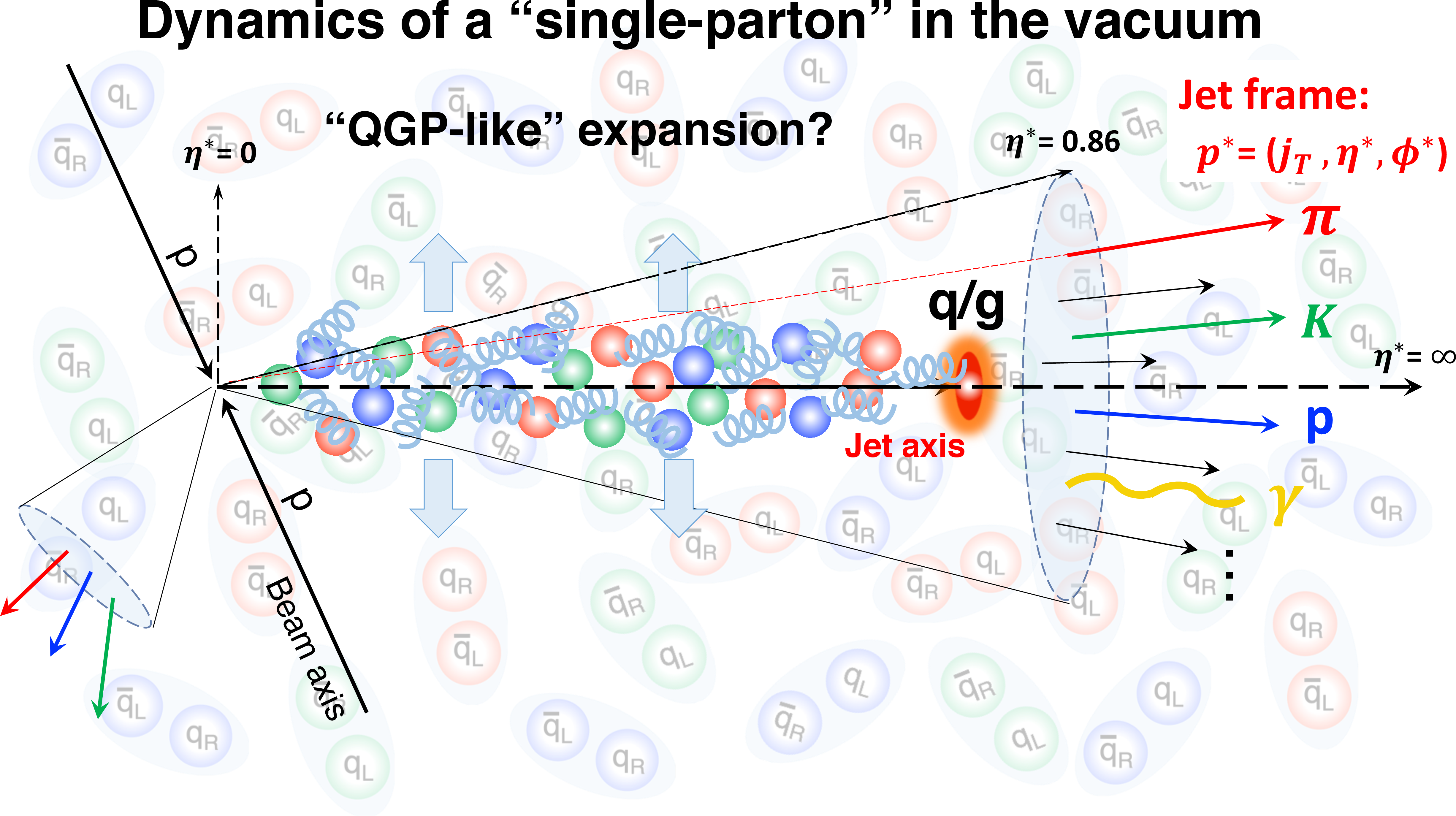
png pdf |
Figure 1:
A schematic illustration of a jet and its constituents in a pp collision, showing the idea of an initial scattered parton eventually exhibiting potential collective expansion in the direction transverse to the jet axis. A jet cone and emerging final state particles are drawn in a coordinate system, denoted the ``jet frame'', where the z axis coincides with the jet direction. Cone size is not to scale. |
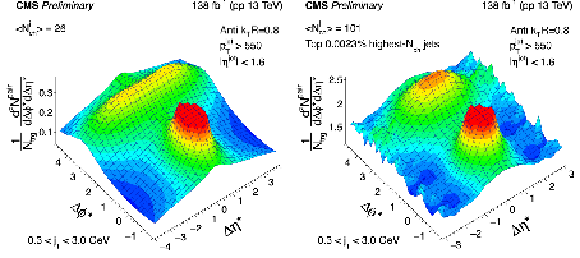
png pdf |
Figure 2:
Examples of 2D two-particle angular correlation functions for particle 0.3 <jT< 3 GeV from all jet multiplicities (left) and the highest (right) in-jet Njch, for anti-kT R= 0.8 jets with jet pT> 550 GeV and |η|< 1.6. |
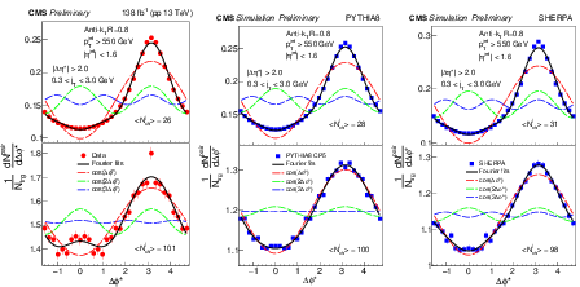
png pdf |
Figure 3:
Examples of 1D two-particle angular correlation functions projected on Δϕ∗ for particles in the range 0.3 <jT< 3 GeV and |Δη∗|> 2, for two in-jet Njch classes in data (left), PYTHIA 8 (middle), and SHERPA (right). The solid black line shows the fitted Fourier function and the colored dashed lines show the individual Fourier components. Vertical bars on data points indicate statistical uncertainty |
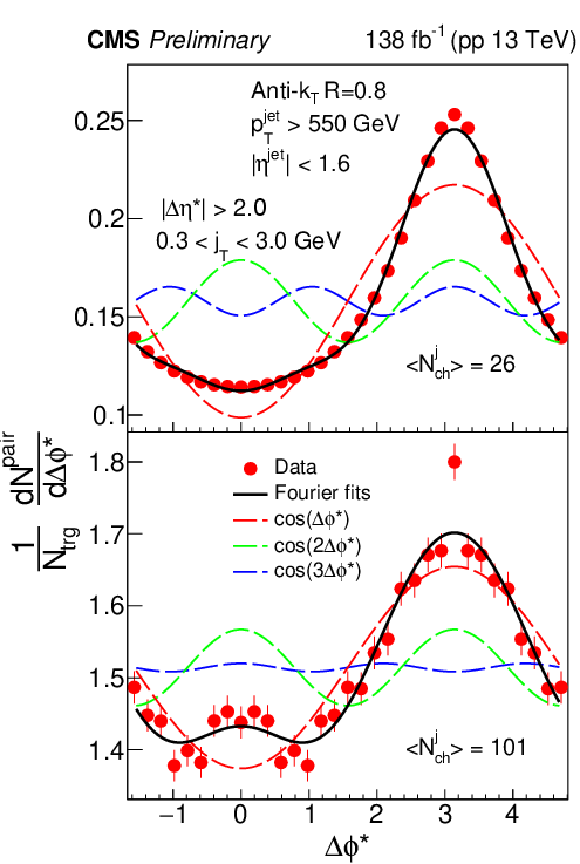
png pdf |
Figure 3-a:
Examples of 1D two-particle angular correlation functions projected on Δϕ∗ for particles in the range 0.3 <jT< 3 GeV and |Δη∗|> 2, for two in-jet Njch classes in data (left), PYTHIA 8 (middle), and SHERPA (right). The solid black line shows the fitted Fourier function and the colored dashed lines show the individual Fourier components. Vertical bars on data points indicate statistical uncertainty |
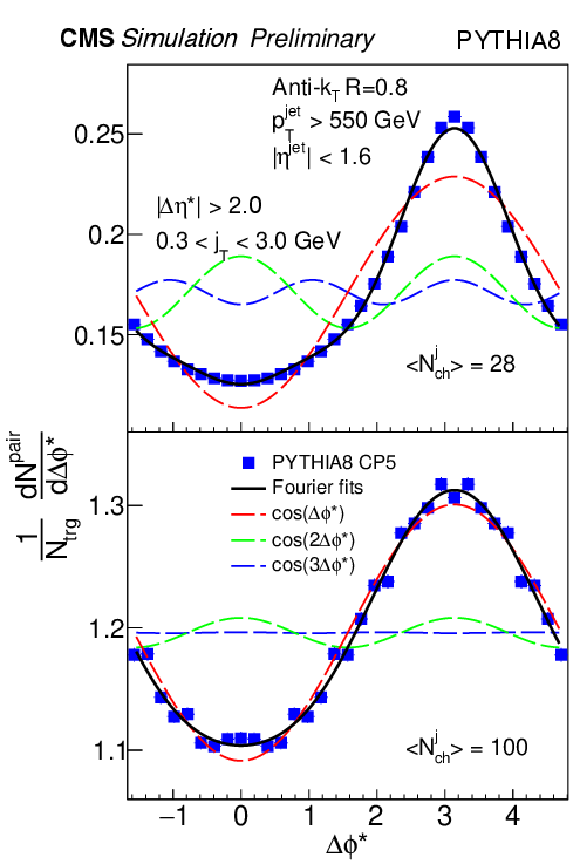
png pdf |
Figure 3-b:
Examples of 1D two-particle angular correlation functions projected on Δϕ∗ for particles in the range 0.3 <jT< 3 GeV and |Δη∗|> 2, for two in-jet Njch classes in data (left), PYTHIA 8 (middle), and SHERPA (right). The solid black line shows the fitted Fourier function and the colored dashed lines show the individual Fourier components. Vertical bars on data points indicate statistical uncertainty |
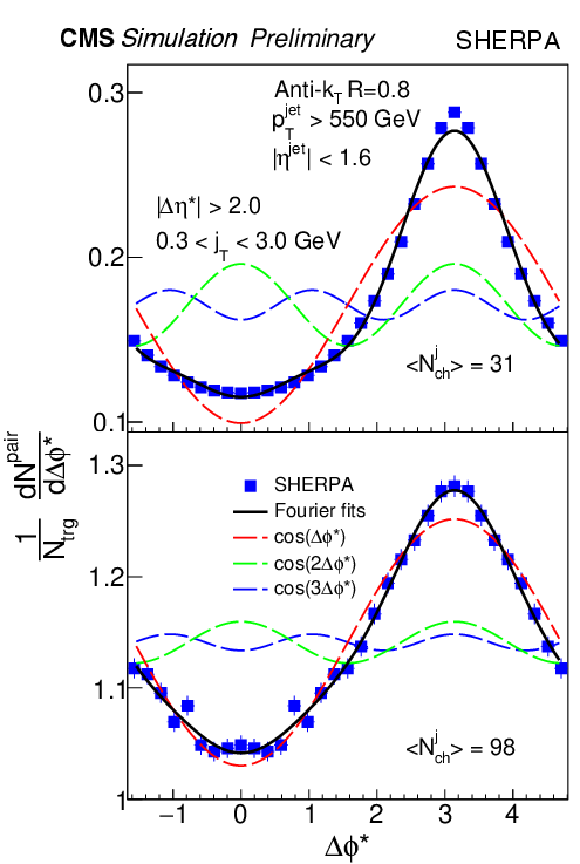
png pdf |
Figure 3-c:
Examples of 1D two-particle angular correlation functions projected on Δϕ∗ for particles in the range 0.3 <jT< 3 GeV and |Δη∗|> 2, for two in-jet Njch classes in data (left), PYTHIA 8 (middle), and SHERPA (right). The solid black line shows the fitted Fourier function and the colored dashed lines show the individual Fourier components. Vertical bars on data points indicate statistical uncertainty |

png pdf |
Figure 4:
The extracted two-particle Fourier coefficients VjnΔ (left) and single-particle elliptic anisotropies vj2{2} (right), as a function of Njch, for anti-kT R= 0.8 jets with jet pT> 550 GeV and |η|< 1.6 jets in pp collisions at 13 TeV from data, PYTHIA 8, and SHERPA. Vertical bars on data points indicate statistical uncertainty in the extracted Fourier component. Vertical grey bands indicate the total systematic uncertainty. |

png pdf |
Figure 4-a:
The extracted two-particle Fourier coefficients VjnΔ (left) and single-particle elliptic anisotropies vj2{2} (right), as a function of Njch, for anti-kT R= 0.8 jets with jet pT> 550 GeV and |η|< 1.6 jets in pp collisions at 13 TeV from data, PYTHIA 8, and SHERPA. Vertical bars on data points indicate statistical uncertainty in the extracted Fourier component. Vertical grey bands indicate the total systematic uncertainty. |

png pdf |
Figure 4-b:
The extracted two-particle Fourier coefficients VjnΔ (left) and single-particle elliptic anisotropies vj2{2} (right), as a function of Njch, for anti-kT R= 0.8 jets with jet pT> 550 GeV and |η|< 1.6 jets in pp collisions at 13 TeV from data, PYTHIA 8, and SHERPA. Vertical bars on data points indicate statistical uncertainty in the extracted Fourier component. Vertical grey bands indicate the total systematic uncertainty. |
| Summary |
| In summary, the first search for long-range near-side correlations and QCD collective effects in jets produced in 13 TeV pp collisions is presented. The measurement is performed using a jet's charged particle constituents, after their kinematic variables have been calculated in a reference frame where the z-axis is defined as the jet direction. Two-particle correlations are studied as a function of the number of charged particle constituents in the jet, Njch, which extends to values of over 100, and the transverse momentum with respect to the jet direction. The first three Fourier harmonics of long-range azimuthal correlations are extracted and compared with those of the PYTHIA8 and SHERPA Monte Carlo (MC) event generators. While data and the MC samples are in good agreement for particle correlations inside low- and mid-Njch jets, the extracted long-range elliptic azimuthal anisotropy vj2{2} shows a distinct increase in data for Njch> 80. Such a feature is not observed in any of MC event generators that model the parton fragmentation process. Therefore, results presented in this note may pave a new direction in uncovering novel effects related to nonperturbative QCD dynamics of parton fragmentation in the vacuum. |
| Additional Figures | |
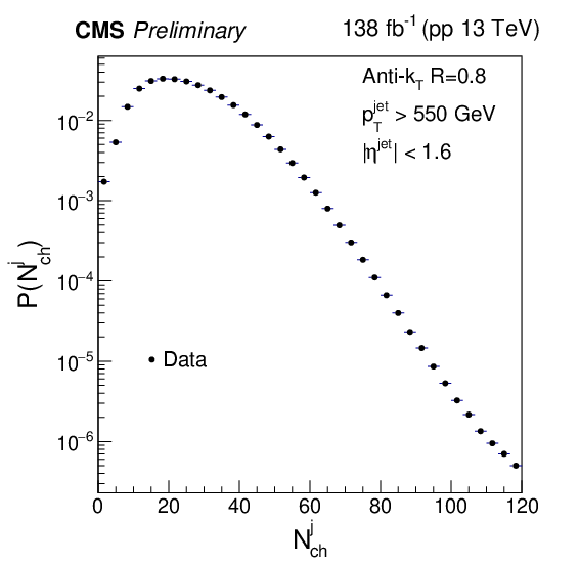
png pdf |
Additional Figure 1:
Distribution of Njch in data. The events of primary interest, high-Njch jets with multiplicity approaching that of ``peripheral'' nucleus-nucleus at LHC [52], are exceptionally rare. |

png pdf |
Additional Figure 2:
Distribution of η∗ for inclusive (red) and high-Njch (blue). The inclusive-Njch class is broader while the narrow high-Njch reaches dN/dη∗ values similar to that produced in ``peripheral'' nucleus-nucleus collisions at LHC [52]. |

png pdf |
Additional Figure 3:
Example of signal (left) and background (right) distributions for inclusive multiplicity jets. The signal is constructed from the average of correlations taken within a single jet, while the background is the average of particle pairs taken from separate jets and events. |
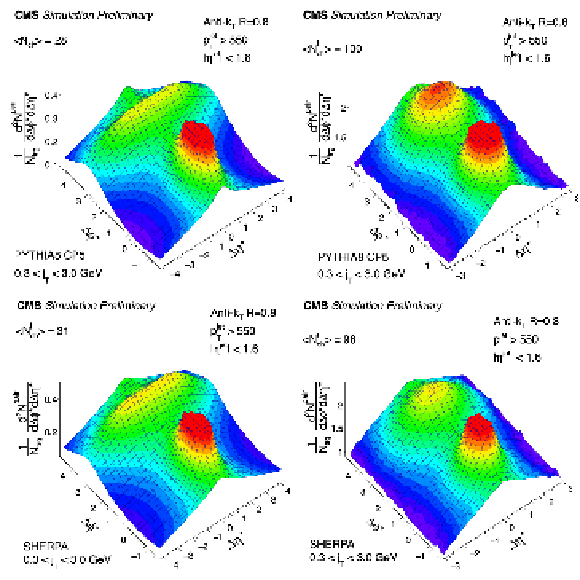
png pdf |
Additional Figure 4:
Examples of 2D two-particle angular correlation functions from PYTHIA 8 [47] (top) and SHERPA [49] (bottom) MC generators for particle 0.3 <jT< 3 GeV from all jet multiplicities (left) and the highest (right) in-jet Njch class, for anti-kT R = 0.8 jets with jet pT> 550 GeV and |η|< 1.6. |

png |
Additional Figure 4-a:
Examples of 2D two-particle angular correlation functions from PYTHIA 8 [47] (top) and SHERPA [49] (bottom) MC generators for particle 0.3 <jT< 3 GeV from all jet multiplicities (left) and the highest (right) in-jet Njch class, for anti-kT R = 0.8 jets with jet pT> 550 GeV and |η|< 1.6. |

png |
Additional Figure 4-b:
Examples of 2D two-particle angular correlation functions from PYTHIA 8 [47] (top) and SHERPA [49] (bottom) MC generators for particle 0.3 <jT< 3 GeV from all jet multiplicities (left) and the highest (right) in-jet Njch class, for anti-kT R = 0.8 jets with jet pT> 550 GeV and |η|< 1.6. |
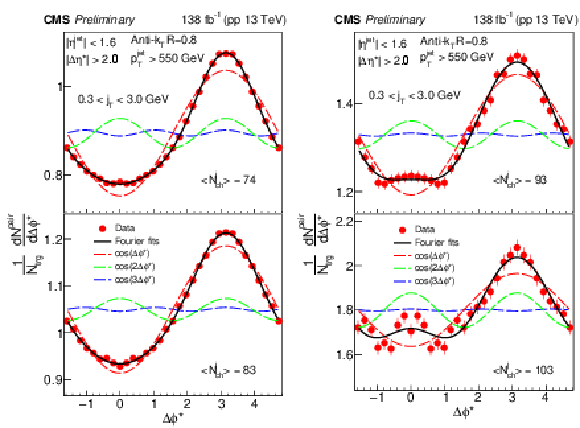
png pdf |
Additional Figure 5:
Examples of 1D two-particle angular correlation functions projected on Δϕ∗ for particles in the range 0.3 <jT< 3 GeV and |Δη∗|> 2, for the four highest in-jet Njch classes in data. The solid black line shows the fitted Fourier function and the colored dashed lines show the individual Fourier components. Vertical bars on data points indicate statistical uncertainty. |
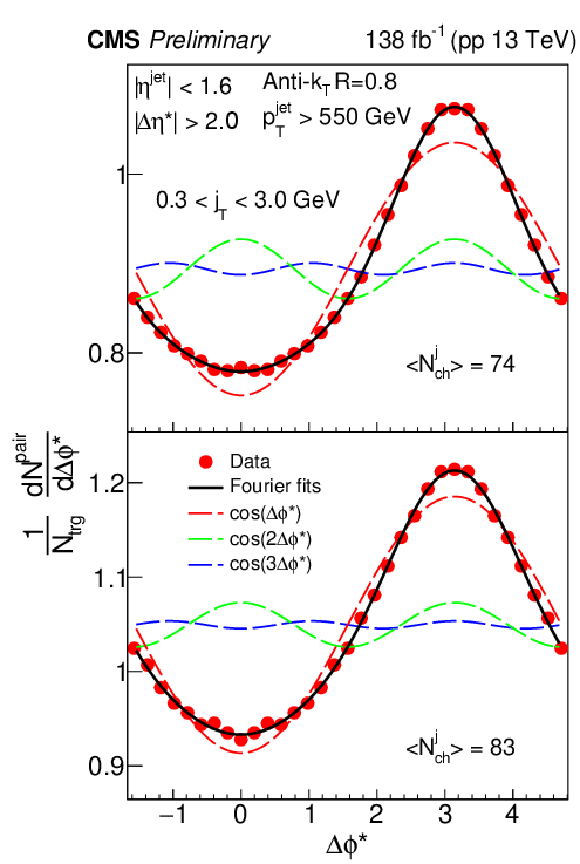
png pdf |
Additional Figure 5-a:
Examples of 1D two-particle angular correlation functions projected on Δϕ∗ for particles in the range 0.3 <jT< 3 GeV and |Δη∗|> 2, for the four highest in-jet Njch classes in data. The solid black line shows the fitted Fourier function and the colored dashed lines show the individual Fourier components. Vertical bars on data points indicate statistical uncertainty. |
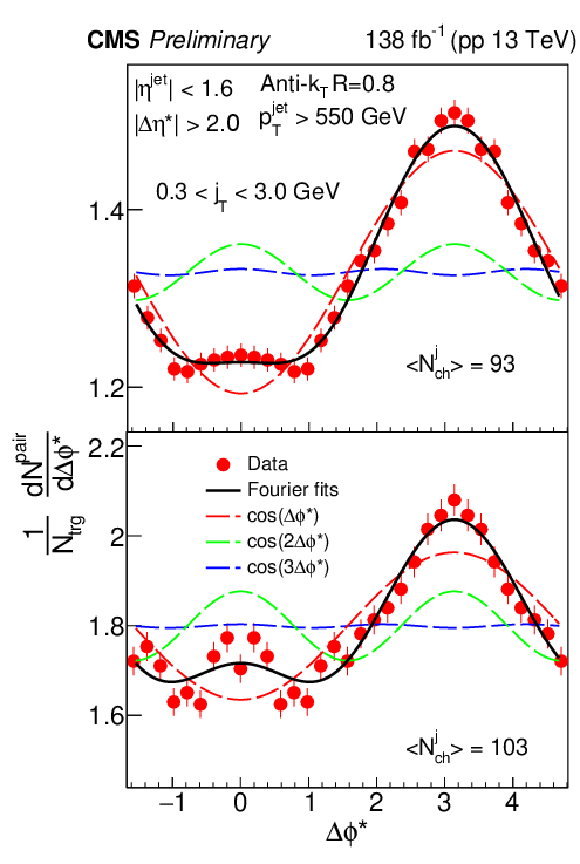
png pdf |
Additional Figure 5-b:
Examples of 1D two-particle angular correlation functions projected on Δϕ∗ for particles in the range 0.3 <jT< 3 GeV and |Δη∗|> 2, for the four highest in-jet Njch classes in data. The solid black line shows the fitted Fourier function and the colored dashed lines show the individual Fourier components. Vertical bars on data points indicate statistical uncertainty. |

png pdf |
Additional Figure 6:
CMS event display of selected high-Njch jet event with a lab-frame pT cut of 1.5GeV. |

png pdf |
Additional Figure 7:
CMS event display of selected high-Njch jet event with no lab-frame pT cut. |
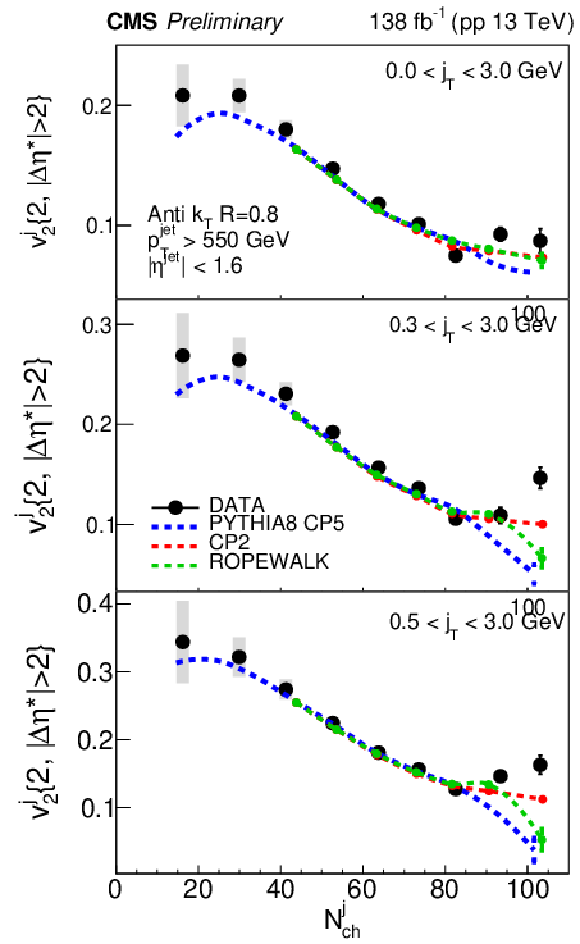
png pdf |
Additional Figure 8:
The extracted single-particle elliptic anisotropies v2{2}, as a function of Njch, for anti-kT R=0.8 jets with jet pT> 550 GeV and |η|< 1.6 jets in pp collisions at 13 TeV from data (black squares) and PYTHIA 8 [47] CP2 [48] (dashed red), PYTHIA 8 CP5 [48] (dashed blue), and Ropewalk with string shoving enabled [47] (dashed green) tunes and settings, respectively. Vertical bars on data points indicate statistical uncertainty in the extracted Fourier component. Vertical grey bands indicate the total systematic uncertainty. |
| References | ||||
| 1 | STAR Collaboration | Distributions of charged hadrons associated with high transverse momentum particles in pp and AuAu collisions at √sNN= 200 GeV | PRL 95 (2005) 152301 | nucl-ex/0501016 |
| 2 | PHOBOS Collaboration | System size dependence of cluster properties from two-particle angular correlations in CuCu and AuAu collisions at √sNN= 200 GeV | Phys. Rev. C 81 (2010) 024904 | 0812.1172 |
| 3 | STAR Collaboration | Long range rapidity correlations and jet production in high energy nuclear collisions | Phys. Rev. C 80 (2009) 064912 | 0909.0191 |
| 4 | PHOBOS Collaboration | High transverse momentum triggered correlations over a large pseudorapidity acceptance in AuAu collisions at √sNN= 200 GeV | PRL 104 (2010) 062301 | 0903.2811 |
| 5 | CMS Collaboration | Long-range and short-range dihadron angular correlations in central PbPb collisions at a nucleon-nucleon center of mass energy of 2.76 TeV | JHEP 07 (2011) 076 | CMS-HIN-11-001 1105.2438 |
| 6 | CMS Collaboration | Centrality dependence of dihadron correlations and azimuthal anisotropy harmonics in PbPb collisions at √sNN= 2.76 TeV | EPJC 72 (2012) 2012 | CMS-HIN-11-006 1201.3158 |
| 7 | ALICE Collaboration | Elliptic flow of charged particles in PbPb collisions at 2.76 TeV | PRL 105 (2010) 252302 | 1011.3914 |
| 8 | ATLAS Collaboration | Measurement of the azimuthal anisotropy for charged particle production in √sNN= 2.76 TeV lead-lead collisions with the ATLAS detector | Phys. Rev. C 86 (2012) 014907 | 1203.3087 |
| 9 | CMS Collaboration | Studies of azimuthal dihadron correlations in ultra-central PbPb collisions at √sNN= 2.76 TeV | JHEP 02 (2014) 088 | CMS-HIN-12-011 1312.1845 |
| 10 | CMS Collaboration | Observation of long-range near-side angular correlations in proton-proton collisions at the LHC | JHEP 09 (2010) 091 | CMS-QCD-10-002 1009.4122 |
| 11 | ATLAS Collaboration | Observation of long-range elliptic azimuthal anisotropies in √sNN= 13 and 2.76 TeV pp collisions with the ATLAS detector | PRL 116 (2016) 172301 | 1509.04776 |
| 12 | CMS Collaboration | Measurement of long-range near-side two-particle angular correlations in pp collisions at √sNN= 13 TeV | PRL 116 (2016) 172302 | CMS-FSQ-15-002 1510.03068 |
| 13 | CMS Collaboration | Evidence for collectivity in pp collisions at the LHC | PLB 765 (2017) 193 | CMS-HIN-16-010 1606.06198 |
| 14 | K. Dusling, W. Li, and B. Schenke | Novel collective phenomena in high-energy proton-proton and proton-nucleus collisions | Int. J. Mod. Phys. E 25 (2016) 1630002 | 1509.07939 |
| 15 | CMS Collaboration | Observation of long-range near-side angular correlations in proton-lead collisions at the LHC | PLB 718 (2013) 795 | CMS-HIN-12-015 1210.5482 |
| 16 | ALICE Collaboration | Long-range angular correlations on the near and away side in pPb collisions at √sNN= 5.02 TeV | PLB 719 (2013) 29 | 1212.2001 |
| 17 | ATLAS Collaboration | Observation of associated near-side and away-side long-range correlations in √sNN= 5.02 TeV proton-lead collisions with the ATLAS detector | PRL 110 (2013) 182302 | 1212.5198 |
| 18 | LHCb Collaboration | Measurements of long-range near-side angular correlations in √sNN= 5 TeV proton-lead collisions in the forward region | PLB 762 (2016) 473 | 1512.00439 |
| 19 | ALICE Collaboration | Long-range angular correlations of pi, K and p in p--Pb collisions at √sNN= 5.02 TeV | PLB 726 (2013) 164 | 1307.3237 |
| 20 | CMS Collaboration | Long-range two-particle correlations of strange hadrons with charged particles in pPb and PbPb collisions at LHC energies | PLB 742 (2015) 200 | CMS-HIN-14-002 1409.3392 |
| 21 | CMS Collaboration | Evidence for collective multi-particle correlations in pPb collisions | PRL 115 (2015) 012301 | CMS-HIN-14-006 1502.05382 |
| 22 | ATLAS Collaboration | Measurement of multi-particle azimuthal correlations in pp, pPb and low-multiplicity PbPb collisions with the ATLAS detector | EPJC 77 (2017) 428 | 1705.04176 |
| 23 | ATLAS Collaboration | Measurement of long-range multiparticle azimuthal correlations with the subevent cumulant method in pp and pPb collisions with the ATLAS detector at the CERN Large Hadron Collider | Phys. Rev. C 97 (2018) 024904 | 1708.03559 |
| 24 | PHENIX Collaboration | Creation of quark-gluon plasma droplets with three distinct geometries | Nature Phys. 15 (2019) 214 | 1805.02973 |
| 25 | STAR Collaboration | Long-range pseudorapidity dihadron correlations in dAu collisions at √sNN= 200 GeV | PLB 747 (2015) 265 | 1502.07652 |
| 26 | PHENIX Collaboration | Measurements of elliptic and triangular flow in high-multiplicity 3HeAu collisions at √sNN= 200 GeV | PRL 115 (2015) 142301 | 1507.06273 |
| 27 | PHENIX Collaboration | Measurements of Multiparticle Correlations in dAu Collisions at 200, 62.4, 39, and 19.6 GeV and pAu Collisions at 200 GeV and Implications for Collective Behavior | PRL 120 (2018) 062302 | 1707.06108 |
| 28 | A. Badea et al. | Measurements of two-particle correlations in e+e− collisions at 91 GeV with ALEPH archived data | PRL 123 (2019) 212002 | 1906.00489 |
| 29 | Belle Collaboration | Measurement of Two-Particle Correlations of Hadrons in e+e− Collisions at Belle | PRL 128 (2022) 142005 | 2201.01694 |
| 30 | ZEUS Collaboration | Two-particle azimuthal correlations as a probe of collective behaviour in deep inelastic ep scattering at HERA | JHEP 04 (2020) 070 | 1912.07431 |
| 31 | ZEUS Collaboration | Azimuthal correlations in photoproduction and deep inelastic ep scattering at HERA | JHEP 12 (2021) 102 | 2106.12377 |
| 32 | CMS Collaboration | Two-particle azimuthal correlations in γp interactions using pPb collisions at √sNN = 8.16 TeV | CMS-HIN-18-008 2204.13486 |
|
| 33 | ATLAS Collaboration | Two-particle azimuthal correlations in photonuclear ultraperipheral PbPb collisions at 5.02 TeV with ATLAS | Phys. Rev. C 104 (2021) 014903 | 2101.10771 |
| 34 | A. Baty, P. Gardner, and W. Li | Collective evolution of a parton in the vacuum: the ultimate partonic ''droplet'', non-perturbative QCD and quantum entanglement | 2104.11735 | |
| 35 | CMS Collaboration | The CMS experiment at the CERN LHC | JINST 3 (2008) S08004 | |
| 36 | CMS Collaboration | Performance of the CMS Level-1 trigger in proton-proton collisions at √sNN= 13 TeV | JINST 15 (2020) P10017 | CMS-TRG-17-001 2006.10165 |
| 37 | CMS Collaboration | The CMS trigger system | JINST 12 (2017) P01020 | CMS-TRG-12-001 1609.02366 |
| 38 | CMS Collaboration | Electron and photon reconstruction and identification with the CMS experiment at the CERN LHC | JINST 16 (2021) P05014 | CMS-EGM-17-001 2012.06888 |
| 39 | CMS Collaboration | Performance of the CMS muon detector and muon reconstruction with proton-proton collisions at √sNN= 13 TeV | JINST 13 (2018) P06015 | CMS-MUO-16-001 1804.04528 |
| 40 | CMS Collaboration | Description and performance of track and primary-vertex reconstruction with the CMS tracker | JINST 9 (2014) P10009 | CMS-TRK-11-001 1405.6569 |
| 41 | CMS Collaboration | Particle-flow reconstruction and global event description with the CMS detector | JINST 12 (2017) P10003 | CMS-PRF-14-001 1706.04965 |
| 42 | CMS Collaboration | Performance of reconstruction and identification of τ leptons decaying to hadrons and ντ in pp collisions at √sNN= 13 TeV | JINST 13 (2018) P10005 | CMS-TAU-16-003 1809.02816 |
| 43 | CMS Collaboration | Jet energy scale and resolution in the CMS experiment in pp collisions at 8 TeV | JINST 12 (2017) P02014 | CMS-JME-13-004 1607.03663 |
| 44 | CMS Collaboration | Performance of missing transverse momentum reconstruction in proton-proton collisions at √sNN= 13 TeV using the CMS detector | JINST 14 (2019) P07004 | CMS-JME-17-001 1903.06078 |
| 45 | M. Cacciari, G. P. Salam, and G. Soyez | The anti-kt jet clustering algorithm | JHEP 04 (2008) 063 | 0802.1189 |
| 46 | M. Cacciari, G. P. Salam, and G. Soyez | FastJet user manual | EPJC 72 (2012) 1896 | 1111.6097 |
| 47 | T. Sjostrand, S. Mrenna, and P. Z. Skands | A brief introduction to PYTHIA 8.1 | Comput. Phys. Commun. 178 (2008) 852 | 0710.3820 |
| 48 | CMS Collaboration | Extraction and validation of a new set of CMS PYTHIA8 tunes from underlying-event measurements | EPJC 80 (2020) 4 | CMS-GEN-17-001 1903.12179 |
| 49 | Sherpa Collaboration | Event generation with Sherpa 2.2 | SciPost Phys. 7 (2019) 034 | 1905.09127 |
| 50 | CMS Collaboration | Pileup mitigation at CMS in 13 TeV data | JINST 15 (2020) P09018 | CMS-JME-18-001 2003.00503 |
| 51 | D. Bertolini, P. Harris, M. Low, and N. Tran | Pileup per particle identification | JHEP 10 (2014) 059 | 1407.6013 |
| 52 | CMS Collaboration | Pseudorapidity distributions of charged hadrons in xenon-xenon collisions at √sNN= 5.44 TeV | PLB 799 (2019) 135049 | 1902.03603 |

|
Compact Muon Solenoid LHC, CERN |

|
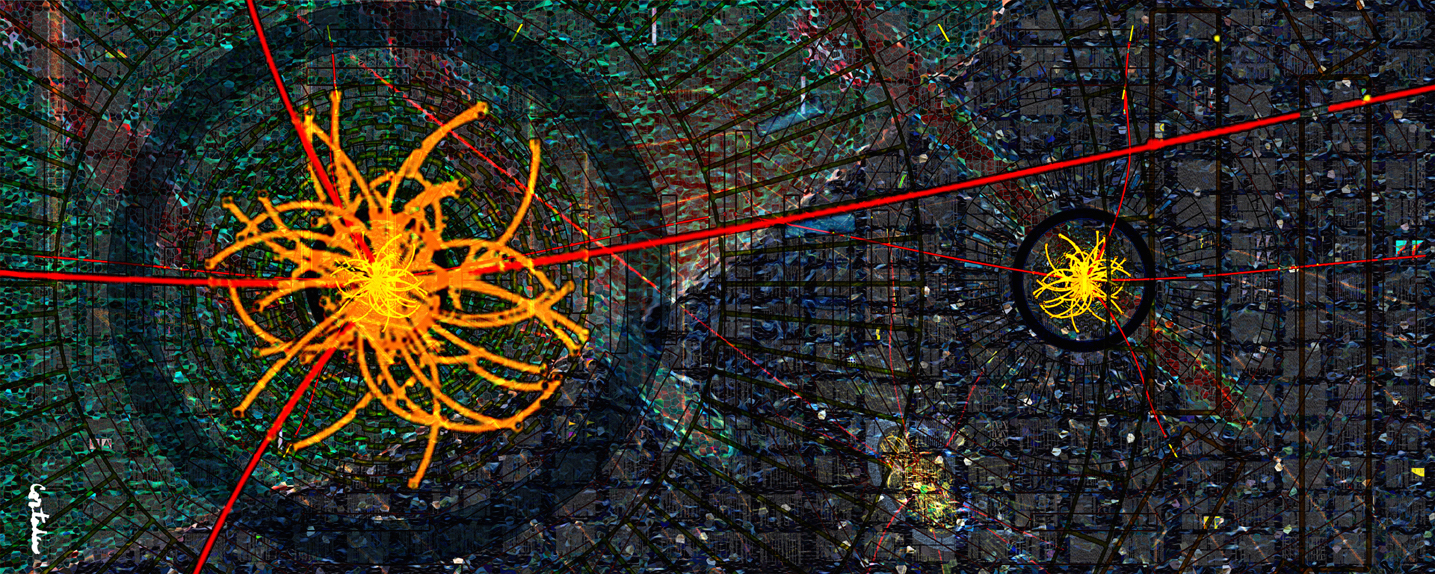
|
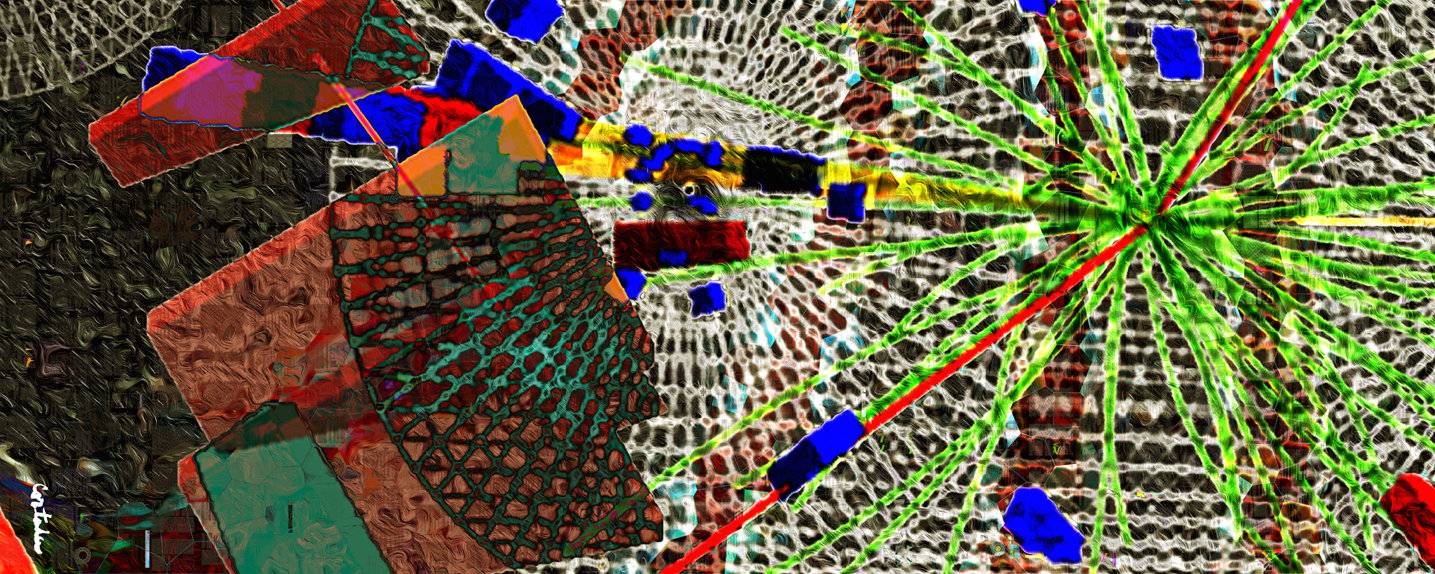
|
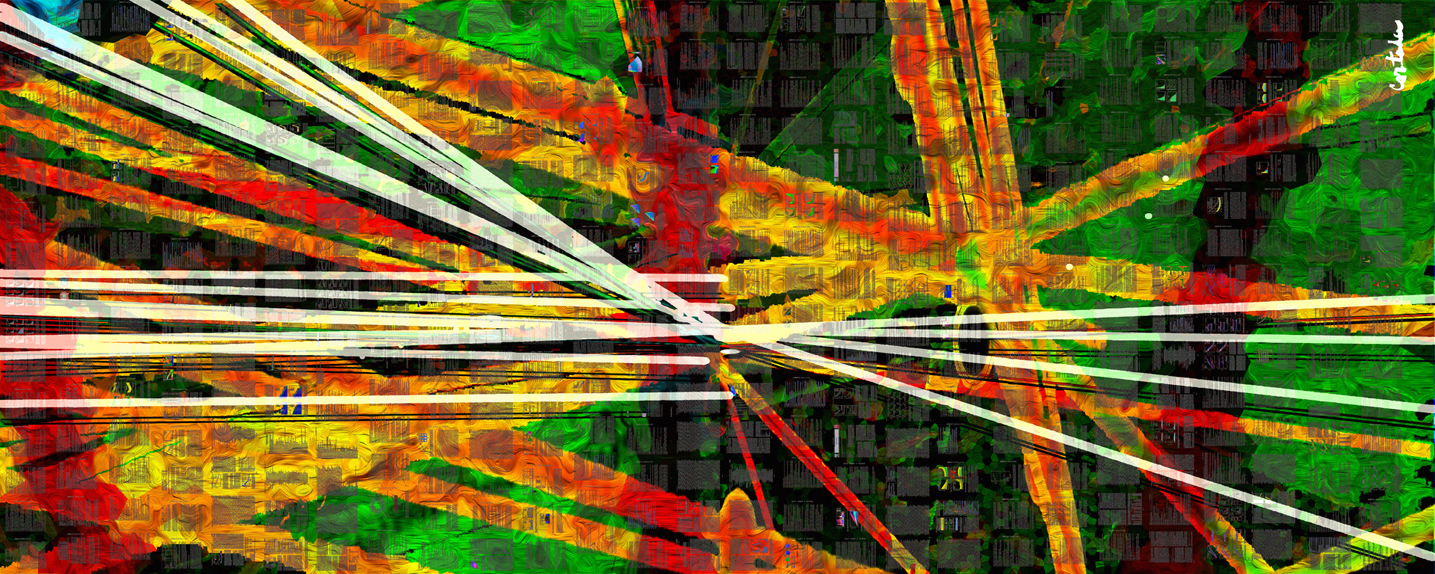
|
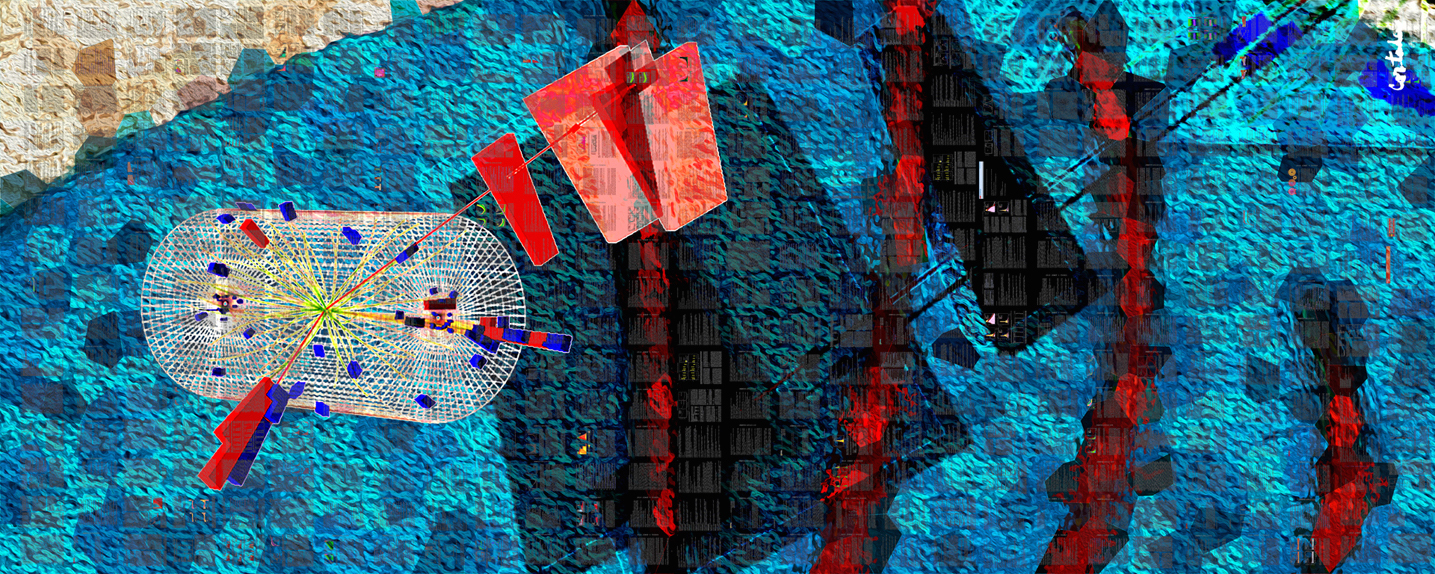
|
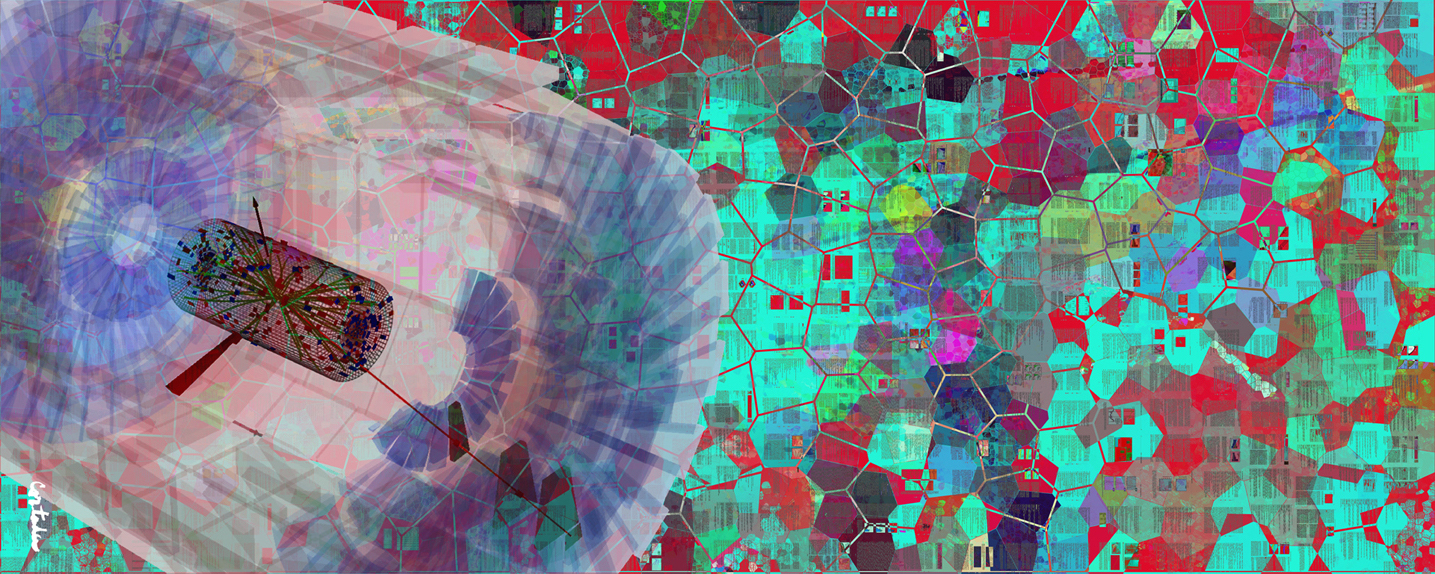
|